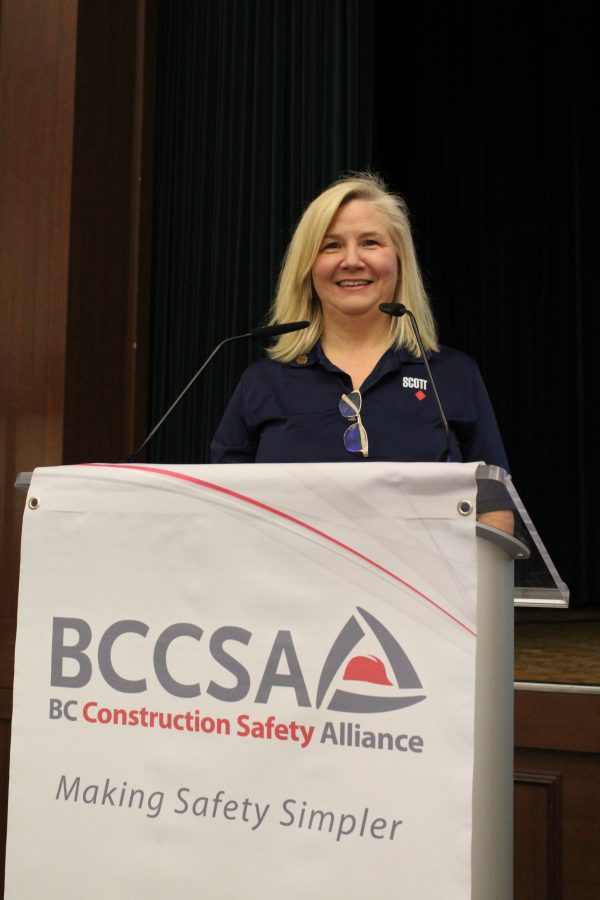The construction industry is starting to look at a hidden problem with deadly consequences.
Donna Grant, a marketing manager at Scott Construction, addressed the issue of suicide for attendees of the British Columbia Construction Safety Alliance’s (BCCSA) Bridging the Gap safety conference on Oct. 26 in Vancouver.
Grant said suicide is the second leading cause of death in the construction industry in men aged 25 to 59, and the highest rates are men from 40 to 59.
“But the good news is that everyone in this room is in a position to change that,” Grant said.
She emphasized that suicide is preventable and despite social stigma “it’s OK to talk about suicide. Asking doesn’t provoke the act, it can in fact reduce anxiety and help people feel understood.
“If you reach out to someone with suicidal thoughts, you may be their one lifeline,” Grant said.
The nature of the construction industry at present also contributes to a culture that is uncomfortable with dealing with suicide and other mental illness issues, Grant said.

“The work can be feast or famine. You can be working crazy long hours and then suddenly be out of work, so there’s a high stress factor to that,” she said.Scott Construction
Demographics also play a role. Construction is still male-dominated, Grant said, and “men don’t tend to seek out help as readily as women might.”
“There’s a perception of if you show how you really feel, you might be seen as weak by your co-workers,” she added.
One of the leading indicators someone is contemplating suicide is if they joke about the matter, Grant said, especially if under the influence of drugs or alcohol.
“The statistics go through the roof if there’s substance abuse involved. It’s a whole new ball game,” she said.
“Those things can go hand in hand, substance abuse and suicide. If that’s part of the equation, you really have to look at the situation with a sense of urgency.”
Other signs to look for include ideation, which is the occurrence of suicidal thoughts, as well as substance abuse and a feeling of being trapped. Those contemplating suicide often also feel hopeless or helpless.
“They feel there’s nothing to do to change the pain they’re feeling and there’s no light at the end of the tunnel,” Grant said.
Don’t judge them. You may have your own opinions on suicide, but if your first reaction is fear, anger will come out of that
— Donna Grant
Scott Construction
Withdrawal from social interaction, anger, engaging in risky behaviour and sudden mood changes are also indicators.
Critical warning signs are if the individual is dramatically happier and appears to be “putting things in order,” or are giving treasured objects away.
“Don’t judge them. You may have your own opinions on suicide, but if your first reaction is fear, anger will come out of that,” Grant said.
She stressed the importance of being direct and asking outright if someone has contemplated suicide.
It’s also important not to be sworn to secrecy and seek out the help of appropriate professionals.
“Ask who can be contacted, so they feel safe and comfortable. In an acute crisis take them to an emergency room, a walk-in clinic, or dial 911.
“Don’t leave them alone, and if there are any means available, get them out of the vicinity,” Grant said.
Organizations and individuals also need to change their perspective to prevent suicide.
“First and foremost, our attitude towards suicide is critical. If we see someone as weak, if that’s part of our regular conversation, someone who may need help is not going to reach out to you because they know you’ll look down on them,” Grant said.
If an organization can do one thing to help prevent suicide, she added, “it’s to do your part to reduce the stigma of mental illness. Be a champion for attitude, awareness, and education.”
Grant’s first experience in talking about suicide came after she joined Scott Construction’s mental health committee, which started two years ago and meets four times a year and consists of 12 volunteer members.
Grant said when she was asked to speak about suicide with site teams, she assumed she would be rejected but discovered strong interest about the topic in Scott’s workforce.
“I was apprehensive at first, but workers were like sponges with the information provided. They embraced the topic right away,” she said.
All the young men she talked to had some experience in their lives regarding suicide, she said, and “were eager to talk about it.”
While the industry is only starting to deal with suicide, Grant said she is optimistic there will be further progress and a reduction in stigma around the topic.
“It’s a seed that’s been planned and it’s starting to bloom. If we keep doing things like having mental health committees, talking about suicide and talking about mental illness, it’s going to improve. It has to,” Grant said.











Recent Comments